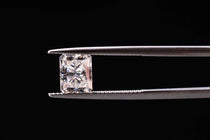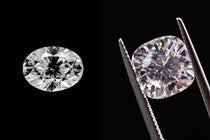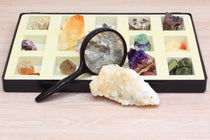In the realm of diamonds, color plays a significant role in determining the value and appeal of these precious stones. An "I color diamond" sits at the nearly colorless end of the diamond color scale, which ranges from D (colorless) to Z (light yellow or brown). You might consider an I color diamond as a prudent investment, possessing a balance of quality and affordability, which offers a slight hint of color that's often imperceptible to the untrained eye when set in jewelry.
Understanding the nuances of an I color diamond is crucial, especially if you're contemplating a purchase. The subtle color present in these diamonds typically does not detract from their brilliance or fire, provided they are cut and set well. Since color is less obvious in mounted diamonds, especially in certain settings and shapes, your I color diamond can exhibit the sparkling allure akin to higher graded colorless stones but at a more budget-friendly price point.
The grading of an I color diamond takes into account the presence of nitrogen, which can affect the diamond's color. Laboratories such as the Gemological Institute of America (GIA) assess these slight color variations meticulously. If you're exploring gem colored diamond options, specifically the type Ib diamonds that may exhibit colors other than yellow, it's important to understand the role of defects and structural imperfections in influencing the diamond's hue.
Understanding Diamond Color
When you're exploring the world of diamonds, one of the critical factors affecting a diamond's appearance and value is its color. The Gemological Institute of America (GIA) devised the GIA Color Grading Scale to categorize diamond color consistently. This scale ranges from D to Z. Diamonds graded D are considered colorless, the highest grade, and often the most sought-after.
As the scale progresses towards Z, diamonds acquire a more noticeable yellow or brown tint. It's essential to realize that slight color differences can significantly affect a diamond's value, even if these differences are not immediately apparent to the untrained eye.
Near-colorless diamonds—grades G through J—provide a cost-effective balance. They possess a minimal hint of color, which can usually be balanced by the right setting and cutting style, making them a popular choice.
When considering an I color diamond, it fits within the near-colorless category. Such diamonds can present a great value as they typically appear white in the setting, especially to the casual observer, and are less expensive than higher color grades.
Your diamond's color can influence both aesthetic appeal and budget considerations. It's vital to view diamonds in person or request high-quality photos to see the subtle color differences before making your decision. Remember, the setting you choose can either complement or contrast with the diamond's color, potentially making it appear more or less colorless relative to its actual grade.
The Significance of I Color Diamonds

Within the spectrum of diamond color grades, I color diamonds offer a balance between cost and aesthetics, providing you with value for money while maintaining an appearance that is often indistinguishable from higher grades to the untrained eye.
Defining I Color Diamonds
I color diamonds fall under the "near-colorless" range on the GIA color scale, which includes grades from D (colorless) to Z (light color). Diamonds in this category may exhibit a faint yellow tint, especially when compared to the colorless grades, though this is generally not perceptible without comparison.
Comparing I Color to Higher and Lower Grades
Compared to diamonds of a higher color grade, I color diamonds can offer more value for money. They may appear similarly colorless as G or H color diamonds particularly in certain settings. Against lower color grades, like J or K, I color diamonds typically show less color and can be closer in appearance to the colorless grade.
Visibility in Various Lighting Conditions
Under controlled lighting, such as that used in jewelry stores, I color diamonds may appear colorless. However, the faint yellow tint may become more visible in broad daylight or under bright, white light. Yet, for many, this subtlety often goes unnoticed by the untrained eye.
Market Perception and Demand
In the diamond industry, perception often dictates value. I color diamonds are perceived as a practical choice, striking a balance between a minimal color presence and affordability. This perception has fostered a steady demand among buyers looking for value for money without compromising on the label of a near-colorless diamond.
I Color Diamonds in Jewelry Settings
Your choice of setting can influence the appearance of an I color diamond. Settings in yellow gold or rose gold can mask the color and make it appear more colorless. In contrast, white gold and platinum can sometimes highlight the diamond's inherent color, yet this is often subtle and can still complement an engagement ring or other jewelry pieces beautifully.
Influences on Diamond Appearance

| Influence Factor | Description |
|---|---|
| Color Grading | The Gemological Institute of America (GIA) grades diamonds on a color scale from D (colorless) to Z (light color). I color diamonds fall within the near-colorless range, and their appearance is influenced by the specific hue and tone within this grade. |
| Setting Metal | The metal used in the diamond setting can impact its appearance. Yellow or rose gold settings can complement the warmth of I color diamonds, making them appear whiter. White gold or platinum settings may enhance the diamond's color contrast. |
| Cut Quality | Well-cut diamonds with excellent proportions can optimize light reflection and brilliance, positively influencing the overall appearance of an I color diamond. A proper cut can also help hide some of the color, making the diamond appear whiter. |
| Fluorescence | Some I color diamonds may exhibit fluorescence when exposed to ultraviolet light. Fluorescence can have varying effects on appearance; for example, blue fluorescence may counteract the yellowish tint in certain lighting conditions, making the diamond appear whiter. |
| Size and Shape | The carat weight, size, and shape of the diamond can impact how color is perceived. Larger diamonds may display color more prominently, while certain shapes may distribute color differently. For instance, round brilliant cuts can show color less noticeably than step-cut shapes like emerald cuts. |
| Personal Preferences | Individual preferences play a significant role. Some people may appreciate the warmth and character of I color diamonds, while others may prefer a whiter appearance. Understanding personal preferences is crucial in selecting the right diamond. |
| Lighting Conditions | The environment in which the diamond is viewed can influence its appearance. Different lighting conditions, such as natural daylight, warm incandescent light, or cool fluorescent light, may emphasize or minimize the diamond's color. |
| Certification | Always consider diamonds certified by reputable gemological laboratories like GIA. The certification provides detailed information about the diamond's color grade and other characteristics, ensuring transparency in the buying process. |
When selecting an I color diamond, understanding how different factors such as cut, carat weight, and fluorescence affect its appearance is crucial to making an informed decision.
Impact of Cut on I Color Diamonds
The cut of a diamond significantly influences its appearance. A high cut quality in I color diamonds can enhance brilliance and fire, making the diamond appear whiter than its color grade suggests. Specifically, a round brilliant cut is known for its ability to maximize light return, which can diminish the visibility of yellowish hues inherent in I color diamonds.
Influence of Carat Weight on Color Visibility
As the carat weight and size of I color diamonds increase, so does the visibility of their color. You might notice the hue more easily in larger diamonds, which is why balancing carat size with cut quality and clarity is important for maintaining the desired appearance.
Role of Fluorescence in I Color Diamonds
Fluorescence can play a dual role in I color diamonds. Blue fluorescence might counteract yellowish tones, potentially making the diamond appear closer to a colorless diamond. However, it is essential to avoid overestimating fluorescence; not all I color diamonds exhibit this characteristic, and its effect varies from stone to stone.
Metals and Diamond Color Interaction
The choice of setting can impact the perceived color of I color diamonds. Yellow or rose gold can emphasize the diamond’s warm tones, while a white metal setting such as platinum or white gold can provide a contrast that makes the diamond appear more colorless.
The Effect of Diamond Shapes on Color
Different diamond shapes also affect the color appearance of I color diamonds. For example, emerald cut diamonds reveal more color due to their large tables and open facets, while princess cut diamonds hide color better due to their unique facet patterns. Selecting the right shape can influence the diamond's overall appearance and perceived color.
Pricing and Value of I Color Diamonds

When considering I color diamonds, it's crucial to understand how their color grade affects pricing and perceived value, as well as how they compare to diamonds with different color grades.
Analyzing the Price of I Color Diamonds
I color diamonds strike a balance between cost and quality, often regarded as 'near-colorless' by gemological standards. They present a slight tint of color that isn't usually perceptible to the untrained eye, especially when set in a ring or piece of jewelry. This subtle color variance can make I color diamonds more affordable compared to higher color grades, providing good value to cost-conscious buyers.
- Diamond Price: Generally lower than that of higher graded colorless diamonds.
- Affordability: Increased for buyers seeking a larger stone at a lower price.
Comparison with Higher Color Grades
I color diamonds are a step below the more sought-after G or H color diamonds and several steps from the premium D color diamond, which is considered the highest color grade with no hue. The price difference can be substantial, with J color diamonds and even more so with D, G, or H color diamonds commanding a premium price.
- Price Difference: More noticeable as the color grade increases.
- Value: Best assessed in comparison to what you are seeking in terms of balance between color and cost.
Cost Versus Aesthetics
While I color diamonds offer a slight warm tint, their beauty can still be remarkable, making them an excellent choice for those who prioritize size and price over color. These diamonds can reflect nearly as much light as their higher-graded counterparts, maintaining their brilliance and scintillating effect when well-cut.
- Balance: Between the aesthetics of near-colorless appeal and expenditure.
- L Color: Noticeably more tinted and typically less expensive than I color.
Expert Buying Recommendations
Mike Fried, CEO and an expert in the field, suggests that in the diamond buying process, one should focus on a diamond that appears beautiful to the naked eye, rather than investing in higher grades that have imperceptible differences in color but a higher price. It's essential to prioritize your preferences and consider where you can compromise to stay within budget.
- Experts: Recommend focusing on the overall appearance and beauty of the diamond.
- Diamond Buying Process: Look for a diamond that balances quality and affordability.
Remember, I color diamonds present a great opportunity for value without significantly compromising on aesthetic appeal.
Certification and Standardization

When considering an I color diamond, understanding the nuances of certification and how these gems are standardized is crucial for making an informed choice.
Understanding the GIA Color Scale
The GIA Color Scale is a cornerstone in the diamond industry for grading diamond color. This scale starts with D (colorless) and moves down to Z, indicating a light yellow or brown tint. Your I color diamond falls into the near-colorless range, with a faint yellowish tint not typically visible to the unaided eye, especially when mounted.
Comparing Different Certification Entities
It's essential to know that not all diamond certifications are created equal. GIA, or the Gemological Institute of America, is considered the gold standard for diamond grading. However, there are other entities such as EGL or IGI, which might offer certifications, but their criteria might not be as stringent. When comparing diamonds, consider ones certified by GIA for a consistent and reliable grading. Companies like Blue Nile and James Allen often provide GIA-certified diamonds.
Grading Criteria for I Color Diamonds
Grading an I color diamond involves examining the gem under controlled lighting and precise viewing conditions. GIA grades diamonds using the D-to-Z diamond color-grading system with a strict process that includes comparing your diamond under 10x magnification against stones of a predetermined color. The presence of color – or lack thereof – affects a diamond's value, where the 'I' grade signifies a good balance of value and appearance among the near-colorless grades. Remember that color is just one part of the Four Cs (Color, Clarity, Cut, Carat) when assessing a diamond’s quality.
Also Read
Frequently Asked Questions
In this section, you'll find concise answers to common queries about I color diamonds, helping you make informed decisions regarding their pricing, appearance, and quality in comparison to other diamond color grades.
What factors affect the pricing of an I color diamond?
The pricing of an I color diamond is influenced by several factors, including its carat weight, cut quality, clarity, and whether it has been treated. The I color grade sits lower on the color scale and is typically less expensive than higher-grade color diamonds.
How does an I color grade impact the overall appearance of a diamond?
An I color grade can result in a diamond exhibiting a slight tint, which isn't usually noticeable to the untrained eye, especially when set in yellow gold or rose gold which can mitigate the color perception.
What should be considered when purchasing an I color diamond ring?
When purchasing an I color diamond ring, consider the setting and style of the ring, as certain designs can enhance the diamond’s appearance. Also, consider the lighting under which you view the diamond, as this can affect its color visibility.
How does I color compare to VS2 clarity in diamonds?
I color and VS2 clarity are different aspects of a diamond; I color refers to a diamond's color, whereas VS2 clarity indicates very slight inclusions. The combination of I color and VS2 clarity can offer a good balance between cost and visual appeal.
What are the visual differences between H color and I color diamonds?
H color diamonds are one grade higher than I color diamonds and typically appear whiter. An I color diamond may show a slight tint when compared side by side, but when isolated, the difference can be challenging to discern.
Is there a noticeable difference in quality between G color and I color diamonds?
There can be a noticeable difference in color between G color and I color diamonds, with G being near colorless and I showing a slight yellow or brown tint. The difference in quality is less about inherent value and more about personal preference for colorlessness.
Checkout some of our top collections:








